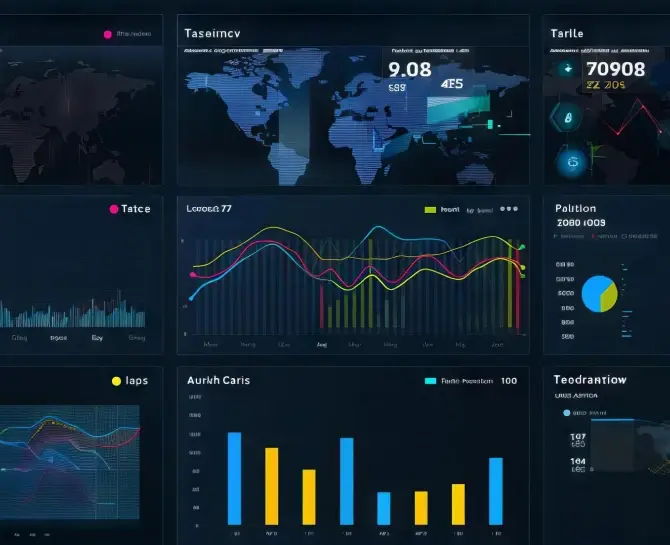Research shows companies that systematically study their prospects and clients grow three to ten times faster and become up to two times more profitable than others. B2B performance marketing strategies have become vital for survival in today’s competitive world.
Marketing executives know this well – 64% strongly believe that evidence-based marketing is a vital part of the modern economy. The numbers make sense since 80% of people visit websites to evaluate service providers, making websites the most popular information source. More than 60% of buyers check out new service providers on social media before deciding, which now matters more than formal referrals.
Salesforce’s research reveals something remarkable – teams that set clear goals become 376% more likely to succeed. Many enterprise sales teams still find it hard to create B2B performance marketing campaigns that show real results.
This piece will show your team how to become skilled at B2B performance marketing that generates qualified leads and boosts conversions. We’ll cover LinkedIn advertising strategies, CRM integration techniques and everything you need to optimize your enterprise sales funnel and track marketing ROI.
What is B2B Performance Marketing?
B2B organizations have made a major move in their marketing approach through performance marketing. B2B performance marketing uses data to pay for measurable outcomes instead of advertising space. Companies can now track tangible results that boost revenue – from clicks and lead generation to completed sales.
The accountability sets performance marketing apart. Teams start each campaign with clear success metrics to track how marketing spending converts to business results. This detailed tracking lets enterprise teams optimize their campaigns with live data and adjust tactics based on what works.
How It Is Different from Brand Marketing?
Performance marketing and brand marketing have key differences in their goals and timelines. Performance marketing tracks immediate, measurable actions from investment to outcome. Marketing teams design it to generate specific responses like demo requests, email signups, or purchases that link directly to their efforts.
Brand marketing takes a longer-term view. Teams build awareness, reputation, and emotional connections over time. Their activities include:
- Expertise content
- Public relations initiatives
- Social media involvement
- Sponsorships and events
Performance marketers optimize landing pages and ad spend daily to meet quarterly sales qualified lead targets. Brand marketers focus on consistent messaging to position their company as an industry innovator. Success in performance marketing comes through metrics like cost-per-click, conversion rates, and return on ad spend. Brand marketing results take longer to measure.
Notwithstanding that, these approaches work together. A Gartner study showed 38% of tech marketers who cut brand awareness spending saw their performance marketing results drop. Interbrand reports companies worldwide lost about $200 billion in revenue in 2023 by focusing too much on performance marketing instead of brand building.
Why It Matters for Enterprise Sales Teams?
Enterprise sales teams gain vital advantages from performance marketing that affect business results. Marketing spending becomes transparent – showing exactly where money goes and what it achieves. This clear view helps justify marketing investments to stakeholders who want proof of return on investment.
Performance marketing lines up well with enterprise sales cycles and connects marketing activities to sales results. Marketing teams cooperate with sales departments to deliver qualified, sales-ready leads. This partnership helps enterprise teams handle complex B2B purchasing processes.
Teams benefit from performance marketing’s flexibility. They can launch targeted campaigns and grow based on proven success, which reduces financial risk while maximizing returns. Quick adjustments help capture market trends and stay competitive.
B2B performance marketing recognizes today’s business buying reality. Only 5% of B2B buyers want to purchase right away. This approach lets enterprise teams target ready prospects while building recognition with the remaining 95% who will buy later.
Performance marketing has turned marketing from a cost center into a growth driver. Enterprise sales teams now have a strong framework to achieve measurable business effects. They don’t just generate clicks – they create conversations, opportunities, and closed deals.
Setting Clear Goals and KPIs
Setting precise goals and identifying relevant KPIs create the foundation of successful performance marketing. Marketers who set clear objectives are 376% more likely to succeed than those who don’t. Sales and marketing teams need defined metrics to avoid working toward different outcomes, which could limit growth potential.
Lining Up Marketing with Enterprise Sales Objectives
Marketing goals and corporate business objectives don’t match up as often as they should. Forrester’s Revenue Operations Survey shows that 59% of B2B operations professionals say their plans don’t line up with corporate business objectives. The good news is that 90% of these professionals say their plans match other functional plans across go-to-market teams, which gives us room to build on this progress.
These steps encourage meaningful coordination:
- Start with Joint Planning Sessions – Bring in people from marketing and sales teams who know the day-to-day challenges. Map out what success means from each point of view.
- Define Shared Revenue Targets – Put revenue at the center of coordination. Marketing should handle a specific percentage of the pipeline, while sales converts an agreed portion.
- Establish Clear Responsibilities – Figure out who’s responsible, accountable, consulted, and informed for each project so everyone knows their role.
- Meet Regularly – Hold biweekly reviews to fix bottlenecks, improve lead hand-off processes, and keep moving toward shared goals.
Key Performance Indicators for Digital Marketing
The right KPIs help you track progress, learn about your audience, assess effectiveness, and prove ROI. B2B performance marketing relies on these vital metrics:
Pipeline and Conversion Metrics:
- Marketing Qualified Leads (MQLs)
- Sales Qualified Opportunities (SQOs)
- Conversion rates at each funnel stage
- Closed-won opportunities
Cost Efficiency Metrics:
- Cost Per Lead (CPL): Money needed to get a potential customer
- Customer Acquisition Cost (CAC): Investment required to turn a lead into a customer
- Return on Marketing Investment (ROMI): Calculated as (net return on marketing investment / cost) x 100
Value Metrics:
- Monthly Recurring Revenue (MRR)
- Customer Lifetime Value (CLV)
- Deal size and pipeline velocity
Research shows that 63% of B2B marketers track their marketing/sales funnel as primary KPIs. This makes sense because funnel metrics directly tie to revenue generation.
Your CRM and marketing automation platforms should connect to create a closed-loop reporting system. Both teams can then see which marketing activities create qualified leads and which sales approaches turn them into customers.
How to Measure Performance Marketing ROI?
B2B marketers often talk about Return on Investment (ROI), but they don’t define it well. Most marketers use various efficiency metrics that don’t fit the strict financial definition when they discuss ROI.
The simple ROI formula is:
ROI = (Total Revenue - Total Investment) / Total Investment
A B2B marketing campaign costing $2,500 that generates $25,000 in sales would have a ROMI of 900%. B2B contexts make calculating true marketing ROI challenging because of:
- Longer Sales Cycles – Converting B2B leads can take weeks or months
- Multiple Touchpoints – B2B buyers interact with several channels before buying
- Attribution Complexity – Advanced tracking helps determine which marketing activities deserve credit
Use a multi-touch attribution model that shows each team’s contribution for better measurement. This shows how marketing touchpoints guide conversions and which sales actions close deals.
ROI shouldn’t be the only factor in marketing decisions. Strategic considerations might sometimes matter more than maximizing return on spend. Choose metrics based on your business questions and specific goals.
Understanding Your Enterprise Audience
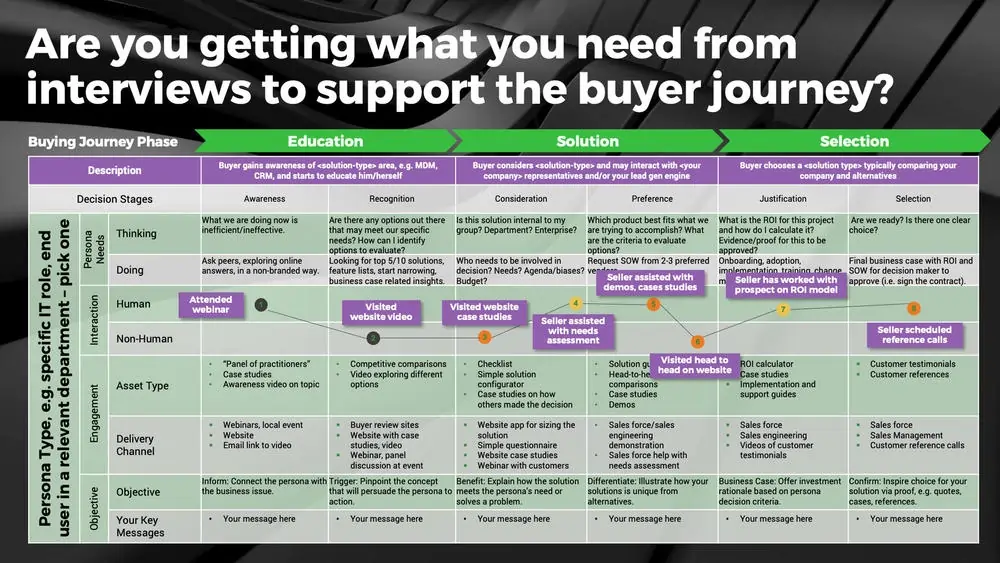
Image Source: Info-Tech
B2B performance marketing success depends on knowing your target audience well. Companies that research their audience systematically grow three to ten times faster. They’re also up to two times more profitable than those working on assumptions.
Building Detailed B2B Buyer Personas
A buyer persona shows your ideal customer’s demographic traits and psychological characteristics. You need to analyze your current customer base to spot common traits among your best clients. This means looking at demographic information, purchase behavior, and customer lifecycle stages.
To build complete B2B buyer personas:
- Analyze firmographic data: company size, industry, revenue, and decision-making processes
- Add demographic information: job titles, roles, and responsibilities
- Add psychographic elements: motivations, challenges, and goals
- List communication priorities: preferred channels and content types
Enterprise sales personas usually need 6-10 decision-makers. These include finance, IT, legal, and business unit leaders. Each leader has different priorities you must address in your marketing efforts.
Mapping the Enterprise Sales Funnel
Enterprise sales funnels are different from traditional models. These deals have higher value, longer cycles (often 6-18 months), and bigger strategic impact. Your enterprise sales funnel needs to show how prospects move through each stage.
The enterprise funnel has awareness, discovery, consideration, and decision stages. Prospects at the top (awareness) try to understand their problem rather than look for solutions. Short, expert-led content that shows industry expertise works best during this phase.
Prospects research options and compare solutions during the consideration stage. About 69% of buyers talk to salespeople only after making their decision. This makes self-service content crucial throughout the buyer’s trip.
Personalizing Content for Different Funnel Stages
B2B purchases need group decisions. Each decision-maker needs content that speaks to their specific concerns. A CFO asks different questions than an R&D or IT head.
Each stage needs its own content strategy:
- Awareness Stage: Blog posts, infographics, and educational videos that help define problems
- Consideration Stage: In-depth guides, case studies, and comparison charts showing product differences
- Decision Stage: Free trials, testimonials, and live demos that reduce perceived risk
B2B decision-making is complex. The path to the bottom of the funnel takes longer and focuses more on evaluation and negotiation. Content that matches both funnel stage and decision-maker role gets better results—personalization boosts sales conversion rates.
Using CRM Data for Segmentation
B2B audience segmentation works best when you use your CRM data to create meaningful groups. B2B segmentation is more complex than B2C because it has multiple decision-makers and formal processes.
B2B CRM systems put all client information in one place. They help analyze customer needs and behaviors. These systems make complex business relationships easier to manage. You can segment based on:
- Need-based criteria: Customer requirements and pain points
- Value-based tiers: Revenue contribution (often 80% of revenue comes from 20% of customers)
- Sophistication levels: How well audiences understand the problems your product solves
Modern B2B CRM systems catch leads automatically. They score leads based on set criteria and organize data clearly for analysis and action.
Smart segmentation powers all your performance marketing efforts. It drives engagement, boosts conversion rates, and builds lasting business relationships.
Choosing the Right Channels
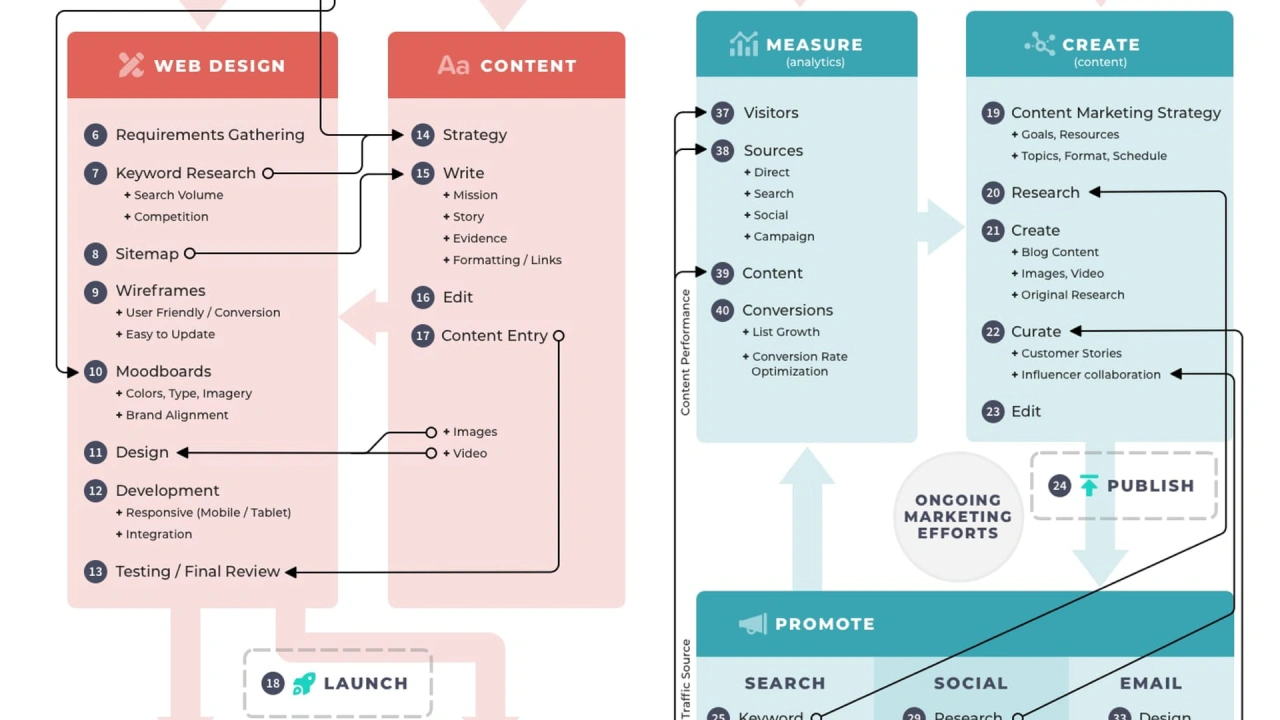
Image Source: LinkedIn
Your campaign’s success depends on choosing the right marketing channels. The right channel choices can mean the difference between wasted budget and exceptional ROI. Here’s a guide to the most meaningful channels for B2B performance marketing.
LinkedIn Advertising Strategies
LinkedIn has emerged as the leading professional networking platform for B2B marketing. The platform connects you to decision-makers with its 450 million users worldwide. Seven out of 10 professionals trust its content. LinkedIn produces better quality leads – HubSpot saw 400% higher lead quality compared to other paid media platforms.
LinkedIn’s advertising formats give you several options:
- Sponsored Content shows native ads in users’ feeds on desktop and mobile devices
- Sponsored Messaging (including Message ads and Conversation ads) lets you communicate one-on-one
- Dynamic ads customize content automatically using profile information
- Text ads show up on the right rail of LinkedIn pages
The platform costs more—lead costs range from $100-$800 and clicks can cost up to $50. Yet its precise targeting makes it worth the investment for companies with high customer lifetime values.
B2B Google Ads and Display Network
Google Display Network reaches 90% of internet users through 2 million websites. This makes it a powerful channel for B2B marketing. GDN also costs less with average CPCs of $0.79 compared to $3.00 for B2B search ads.
You can get better results with responsive display ads that use Google’s AI to arrange your assets across placements. Your images should meet these quality standards:
- Horizontal (1.91:1): 1200 x 628 pixels (recommended)
- Square (1:1): 1200 x 1200 pixels (recommended)
- Vertical (9:16): 900 x 1600 pixels (recommended)
B2B Social Media Advertising Platforms
LinkedIn dominates B2B marketing – 85% of B2B content marketers say it delivers the most value. But other platforms deserve attention based on your audience and goals.
YouTube now beats Instagram in B2B marketing popularity because video content works best. TikTok keeps growing for reaching millennial and Gen Z professionals. The platform works well for behind-the-scenes content, team features, and industry explanations.
Some niche platforms serve specific industries better. Telegram, to name just one example, helps build closer relationships with communities in tech, crypto, and financial sectors.
Account-Based Advertising for High-Value Accounts
Account-based advertising targets decision-makers in companies that show strong interest. Start with a list of companies that visit your site or download resources. Then create custom ads, demos, and exclusive invitations that speak to each account’s needs.
Mentioning a company’s name or their industry challenges grabs attention better than generic ads. This individual-specific approach shows you understand their situation and builds trust.
B2B Retargeting Campaigns Across Channels
Different platforms work better at different funnel stages. Pick platforms based on where prospects are in their buying experience:
- Awareness Stage: YouTube, programmatic display, LinkedIn sponsored posts
- Consideration Stage: Facebook retargeting, LinkedIn InMail, Native ads on B2B media
- Decision Stage: LinkedIn lead gen forms, Google Search retargeting, CRM-based ads
Multiple channels amplify your message and keep your brand visible as prospects move toward decisions. Your CRM data helps personalize retargeting campaigns based on past interactions. This lets you segment audiences and deliver consistent messages across platforms.
These channels create a complete B2B performance marketing system that connects with prospects during their research phase.
Building and Launching Campaigns
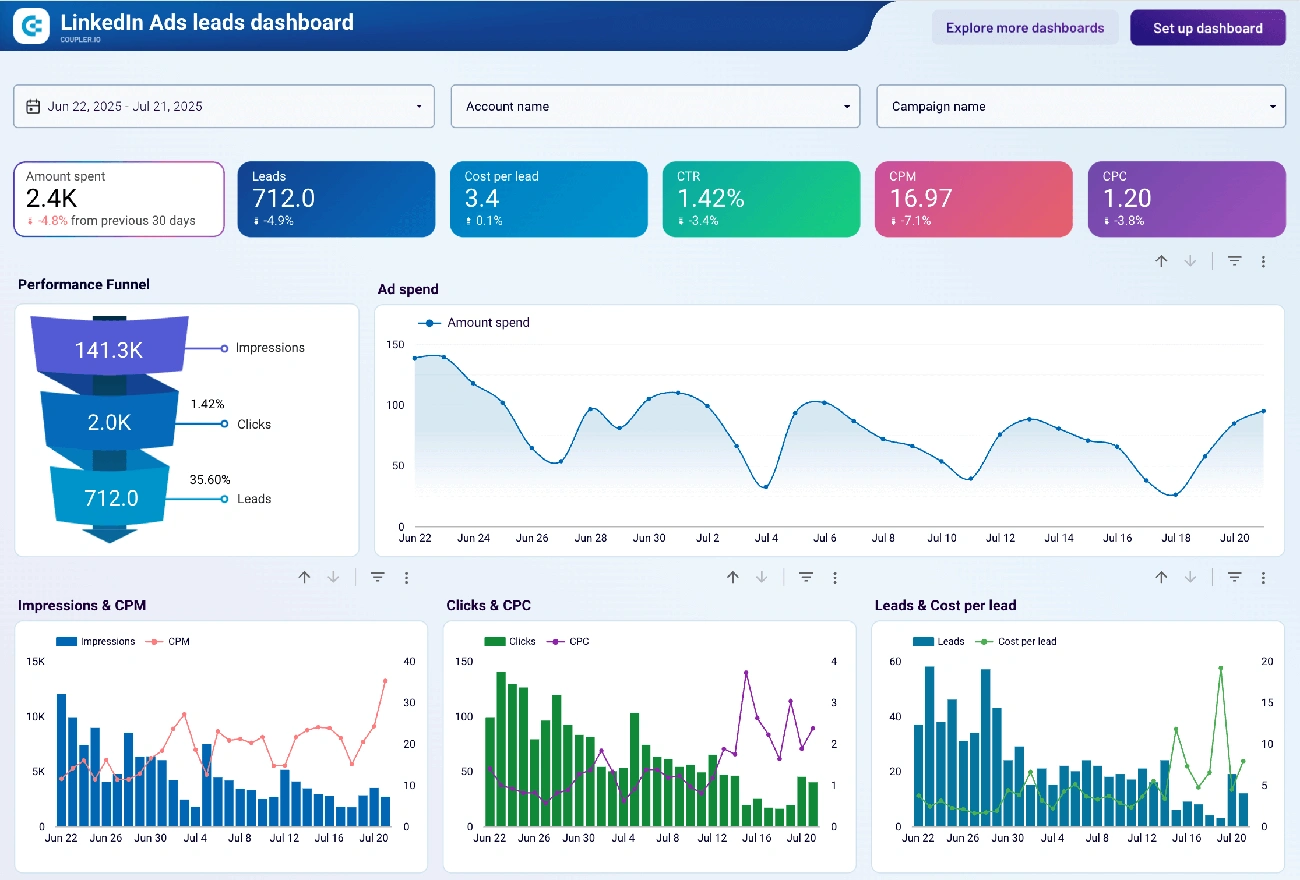
Image Source: Coupler.io Blog
After identifying your target audience and selecting the right channels, you need to create compelling campaigns that produce measurable results. Let’s tuck into the key components that will help your B2B performance marketing campaigns succeed.
Crafting Performance-Driven Messaging
B2B messaging should communicate your offerings’ value throughout the buyer’s experience. Your first step is to create a clear value proposition that appeals to decision-makers’ needs and challenges. Good B2B messaging shows concrete benefits and business outcomes instead of just listing product features.
Your campaign messaging should include these key elements:
- Clarity – Keep messaging straightforward and jargon-free
- Relevance – Tailor content to address specific pain points
- Credibility – Support claims with data and testimonials
- Empathy – Show understanding of audience challenges
Persuasive B2B messaging blends storytelling with emotional intelligence to create deeper connections beyond rational aspects. To cite an instance, showing how your solution will help their business and careers can boost engagement significantly.
Creating Landing Pages That Convert
The best landing pages set clear expectations and line up content with user intent. Successful pages emphasize benefits over features, add social proof, and build trust through smooth user experience.
Your landing pages should be easy to understand and direct with mobile-friendly, fast-loading design. Removing site navigation helps users focus on your conversion goal.
Place your value proposition right in your headline and subheading to show why your product beats alternatives. Make sure you highlight benefits that feel personal and relevant to your audience.
Trust leads to conversions, and B2B buyers are more likely to work with companies that show positive testimonials and case studies. You should add customer quotes, client logos, and certification badges to establish credibility.
Your call-to-action (CTA) should use action verbs like “Book,” “Start,” or “Get” to create clear directions. CTAs should appear throughout the page, and forms should stay visible while scrolling to maximize conversions.
Using LinkedIn Campaign Manager and InMail
LinkedIn Campaign Manager helps you deliver messages directly to your ideal customers. Start by accessing Campaign Manager, creating an ad account, and linking your LinkedIn Page. Next, pick your campaign goal from awareness, consideration, or conversion options.
The platform lets you target based on company size, job titles, skills, and other professional traits. This precise targeting of decision-makers makes LinkedIn stand out for B2B marketing.
You can control spending by setting daily limits, lifetime budgets, or both. The platform also lets you schedule campaigns to run continuously or during specific times.
LinkedIn InMail messages perform exceptionally well—with 10-25% response rates, about 300% higher than emails with similar content. These messages work so well because they reach users through LinkedIn inbox, email inbox, and mobile notifications.
Messages under 100 words work best, as short messages under 400 characters get 22% more responses than average. Write your message with a personal opener, clear value proposition, and simple CTA. A professional yet conversational tone works better than aggressive sales language.
Messages sent on weekday mornings (Tuesday through Thursday) get the most engagement, with 13% higher open rates than weekend messages.
Optimizing for Conversions
Converting website visitors into qualified leads needs careful improvement of your conversion elements. A/B testing can boost conversion rates by up to 49%. Yet only 17% of marketers test their content regularly. This presents a great chance for enterprise teams ready to invest in testing and optimization.
A/B testing for B2B campaigns
A/B testing lets you compare two versions of a webpage, email, or marketing asset. Real data, not assumptions, shows which version works better. B2B marketing teams should test these key elements:
- Call-To-Action Wording – “Get a Free Demo” versus “Schedule a Consultation” can show which gets more qualified leads
- Email Subject Lines – Messages under 400 characters get 22% more responses than average
- Landing Page Layouts – Headlines, image placement, and content length need testing
B2B buyers take longer to make decisions than B2C customers. Your tracking should look at engagement across multiple touchpoints instead of just quick conversions. Tests with specific hypotheses are 3x more likely to create meaningful improvements.
Improving Call-To-Actions and Form Design
Effective CTAs connect directly to your content. Action verbs like “Book,” “Start,” or “Get” create clear direction. One SaaS company’s trial signups jumped 15% just by using contrasting colors for CTA buttons on their pricing page.
Each form field needs careful review. B2B conversion funnels often get stuck because of complex forms. Research shows four fields create the best conversion rates, according to 31% of marketers. These methods can help:
- Roll out progressive profiling to collect information step by step
- Add auto-fill features where possible
- Experiment with different form layouts and field arrangements
Enterprise Sales Funnel Optimization Techniques
Data analysis reveals where prospects drop off in your enterprise funnel. Tools like Hotjar or FullStory show exactly where users get stuck. This helps fix actual problems rather than assumed ones.
Look beyond top-funnel metrics to measure changes throughout the sales process:
- Lead quality: Which version brings better qualified leads?
- Sales conversion: Do certain leads convert more successfully?
- Customer lifetime value: Are some variants attracting higher-value clients?
Your pricing and demo pages need special attention as critical conversion points. Embedded calendars can increase demo requests by 30% or more. Social proof near CTAs gives uncertain prospects the confidence to act.
Technology Stack for Performance Marketing
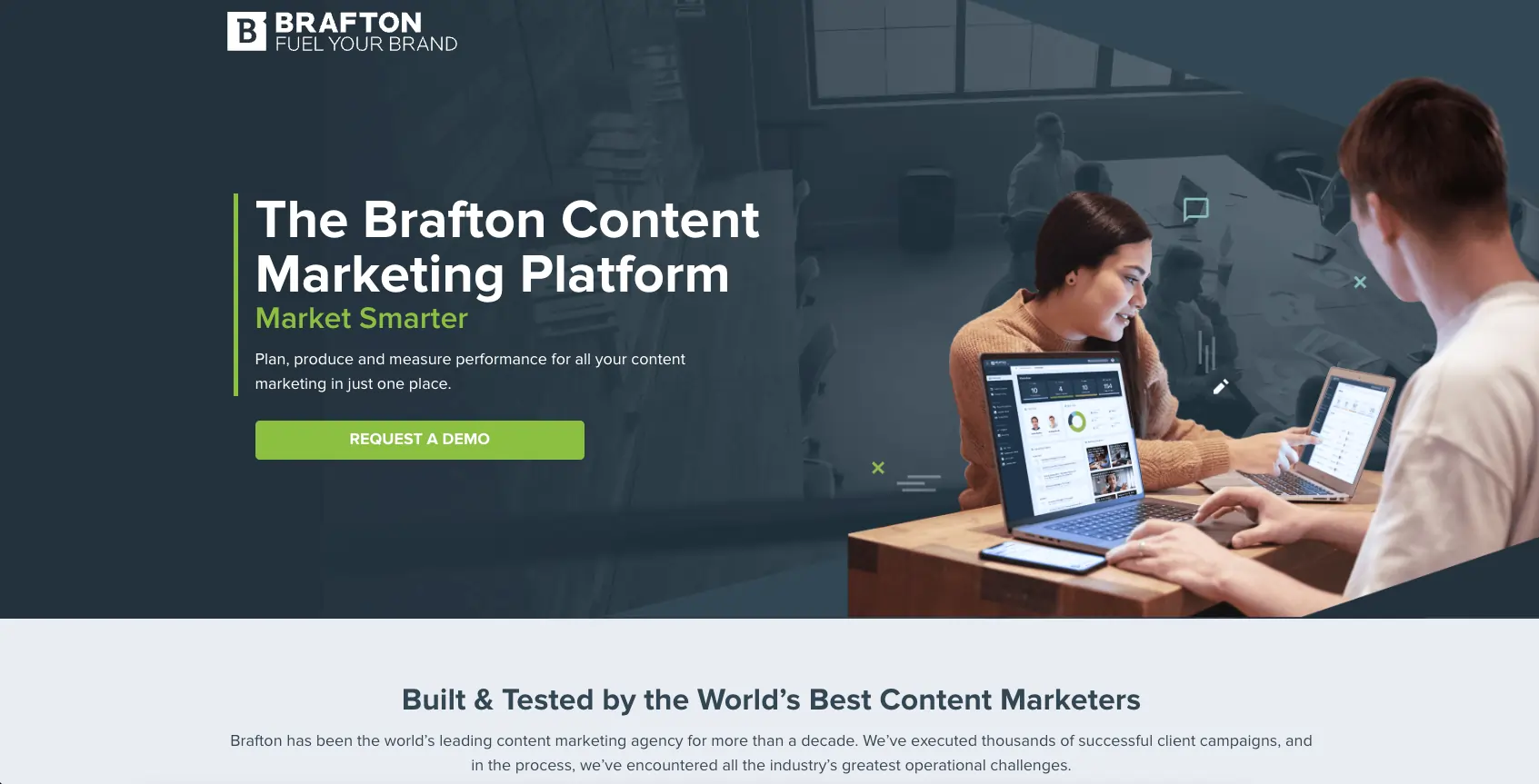
Image Source: Brafton
A reliable technology infrastructure serves as the foundation of successful B2B performance marketing initiatives. The right tech stack can feel like a “superpower” at the time it’s properly implemented. Marketing teams can achieve capabilities that would be impossible to execute manually.
B2B Performance Marketing Tech Stack Essentials
A complete B2B marketing tech stack has several core platforms that work together smoothly:
- Customer Relationship Management (CRM) system
- Marketing Automation Platform (MAP)
- Content Management System (CMS)
- Analytics and reporting tools
- Lead enrichment solutions
These fundamental elements act as the central nervous system of marketing operations. They store customer data and help sales and marketing teams communicate effectively.
Tools For Campaign Management and Analytics
Campaign management tools free marketing teams from routine tasks. Teams can focus on crafting strategic campaigns instead. B2Linked optimizes LinkedIn campaigns, while Terminus excels at account-based marketing. RollWorks creates tailored content experiences. Microsoft Power BI, Salesforce Tableau, and Google Analytics 4 offer vital insights about campaign performance.
CRM Integration for B2B Marketing
Your CRM’s integration with marketing platforms creates a “closed-loop” reporting system. Marketing transforms from a cost center into a growth accelerator. The system maintains consistent data, removes duplicate entries, and presents a complete view of the customer’s trip. Companies with integrated CRM and marketing automation see their sales win rates jump by 30%.
Marketing Automation Tools for Lead Nurturing
Marketing automation handles repetitive tasks such as email sending and social media posting. Your CRM manages customer information and interactions simultaneously. HubSpot, Adobe Marketo, and Salesforce Pardot lead the market. These platforms rank prospects based on their conversion potential through lead scoring. Sales teams can then focus on high-value opportunities.
AI and Predictive Analytics in Performance Marketing
AI-powered predictive analytics helps marketers forecast future trends through historical data analysis. Adobe’s marketing solutions showed up to 50% higher conversion rates. Teams can optimize their budget allocation, adjust bids live, create hyper-personalized ad content, and calculate customer lifetime value.
Tracking, Attribution, and Reporting
Image Source: DiGGrowth
Successful B2B performance marketing campaigns rely on tracking and measurement as their life-blood. Performance marketing gives clear attribution models that track the customer’s trip, which helps marketers prove ROI and arrange efforts directly with revenue generation.
B2B Conversion Tracking Best Practices
Mechanisms that measure campaign performance immediately should be implemented to track conversions optimally. Successful tracking captures data on leads, conversions, and involvement through multiple touchpoints. Google Analytics gives reliable explanations, though many accounts face issues with properly configured tracking. Detailed naming conventions and appropriate attribution models should be included during conversion tracking setup to optimize performance.
Marketing Attribution Models for B2B
B2B buying cycles are complex, so choosing the right attribution model becomes critical:
- First-Touch Model: Assigns credit to the original interaction, useful to evaluate top-of-funnel activities
- Linear Model: Distributes credit equally through all touchpoints and provides a balanced view of marketing efforts
- Time-Decay: Weighs recent touchpoints more heavily and works ideally for longer B2B sales cycles
- W-Shaped: Allocates 30% each to first, middle, and last touches before closure
- Data-Driven: Uses machine learning to analyze all touchpoints and assigns credit based on influence
Using Analytics to Refine Campaigns
Performance marketing makes result measurement straightforward, and you’ll see the effects immediately. Marketing teams often prioritize implementation without taking meaningful action based on attribution results – this happens 31% of the time. Evidence-based insights from analytics should be used to refine campaigns continuously by adjusting ad spend toward high-performing channels, creatives, and audience segments to maximize effects.
Conclusion
B2B performance marketing transforms how enterprise sales teams generate qualified leads and boost conversions. This piece explores the basic components needed to create evidence-based campaigns that deliver measurable results and affect your bottom line.
Success starts when marketing and sales objectives are arranged through clear goals and relevant KPIs. Teams that track specific metrics get better outcomes than those working without defined parameters. Measuring performance accurately depends on picking the right metrics that connect marketing activities to revenue generation.
Understanding your audience is vital to effective B2B marketing. Companies grow faster and become more profitable when they research their prospects systematically. Detailed buyer personas and strategic funnel mapping help you deliver tailored content that addresses specific concerns of multiple stakeholders in target organizations.
Your channel selection should match your audience’s priorities and behaviors. LinkedIn advertising gives unparalleled access to decision-makers. Google Ads offers extensive reach across the internet. Account-based advertising lets you target high-value prospects precisely, which creates opportunities for meaningful connections with key organizations.
Compelling campaigns need performance-driven messaging that shows clear value propositions. High-converting landing pages, strategic CTAs, and optimized forms work together to convert visitors into qualified leads. A/B testing these elements removes guesswork and improves conversion rates based on actual user behavior.
Your technology infrastructure supports all these efforts as a backbone. CRM integration, marketing automation, and analytics tools create a closed-loop system that tracks the customer’s entire experience from original awareness to closed deal. Artificial intelligence now offers predictive capabilities that refine campaign performance through evidence-based insights.
Becoming skilled at B2B performance marketing needs dedication to evidence-based decisions, strategic arrangement between teams, and continuous optimization. Companies that adopt these principles position themselves to accelerate growth in increasingly competitive markets.
Note that effective performance marketing isn’t about running a one-time campaign. It’s about creating a systematic approach that gets more and thus encourages more consistent results over time. Start using these strategies today, measure your outcomes carefully, and adjust based on what the data shows. Your enterprise sales pipeline will benefit.
FAQs
Q1. What Is B2b Performance Marketing and How Does It Differ from Traditional Marketing?
B2B performance marketing is a data-driven strategy where companies pay for specific, measurable outcomes rather than just advertising space. Unlike traditional marketing, it focuses on tangible results that directly contribute to revenue, such as lead generation and completed sales. Performance marketing provides clear tracking from investment to outcome, allowing for real-time optimization of campaigns.
Q2. How Can Enterprise Sales Teams Align Their Marketing and Sales Objectives?
Enterprise sales teams can align marketing and sales objectives by holding joint planning sessions, defining shared revenue targets, establishing clear responsibilities for each team, and meeting regularly to address bottlenecks and refine processes. This alignment ensures both teams work towards common goals and improves overall performance.
Q3. What Are Some Key Performance Indicators (KPIs) for B2b Digital Marketing?
Important KPIs for B2B digital marketing include pipeline and conversion metrics like Marketing Qualified Leads (MQLs) and Sales Qualified Opportunities (SQOs), cost efficiency metrics such as Cost Per Lead (CPL) and Customer Acquisition Cost (CAC), and value metrics like Monthly Recurring Revenue (MRR) and Customer Lifetime Value (CLV).
Q4. Which Advertising Platforms Are Most Effective for B2b Performance Marketing?
LinkedIn is considered the premier platform for B2B marketing due to its professional user base and targeting capabilities. Other effective platforms include Google Ads and Display Network, YouTube for video content, and niche platforms like Telegram for specific industries. The choice of platform should be based on where your target audience spends their time and researches solutions.
Q5. How Can B2b Marketers Optimize Their Campaigns for Better Conversions?
B2B marketers can optimize campaigns by conducting A/B tests on elements like call-to-action wording and landing page layouts, improving form design by reducing fields and implementing progressive profiling, and using analytics to identify and address funnel bottlenecks. Additionally, leveraging AI and predictive analytics can help forecast trends and optimize budget allocation across channels.
About The Author
Get A Free 1 Hour Consultation
I can help you fix your digital marketing strategy that powers your business growth.
No strings attached. No commitments required. No sales pitch from my side about our services. I will give you a patient hearing, understand your business, understand your business growth challenge and suggest various growth strategies you can implement for your business. I will talk about my service offerings, only if you want me to. Not otherwise.


